What Dress Color Should I Wear? Take Our Quiz to Find Out!

Key Takeaways
Colour appears differently to everyone because of your brain, your eyes, light and screens. Anticipate the shift–context and assumptions can turn a dress from blue and black to white and gold.
💫 Discover Your Complete Color Palette
Ready to discover all the colors that make you look radiant? Our comprehensive color analysis will reveal your complete personal palette - perfect for hair, makeup, and wardrobe decisions.
Take Color Analysis Quiz →Try your colours under a few different light sources to get a real feel for them. Try neutral lighting and compare in daylight when you can, to minimize surprises.
Calibrate your screen before you buy a dress online. Calibrate your brightness and colors, and check photos on multiple devices to identify differences.
Be aware that your eyes and memory can influence your decision. Do a simple colour dress test, and trust what you see rather than what you recall or what's trendy.
Let undertone, occasion and personal style lead your color decisions. Construct a basic neutrals-heavy palette and include a couple of undertone-matching power shades.
Go try on dresses in person whenever you can and take fabric, background, and accessories into consideration. Make decisions once you've seen it in real life under different lighting for the best bet.
A colour dress test finds shades that flatter your skin tone, eye color and hair. It categorizes palettes as warm, cool or neutral and then further breaks down into seasons: spring, summer, autumn and winter.
Most such tests rely on natural light, a blank face and plain drapes to test how hues bounce on the face. The goal is clear: pick colors that brighten features and smooth skin.
Next up, steps, tips, and actual examples for everyday wear.
📚 Recent Articles
Why we see colour differently
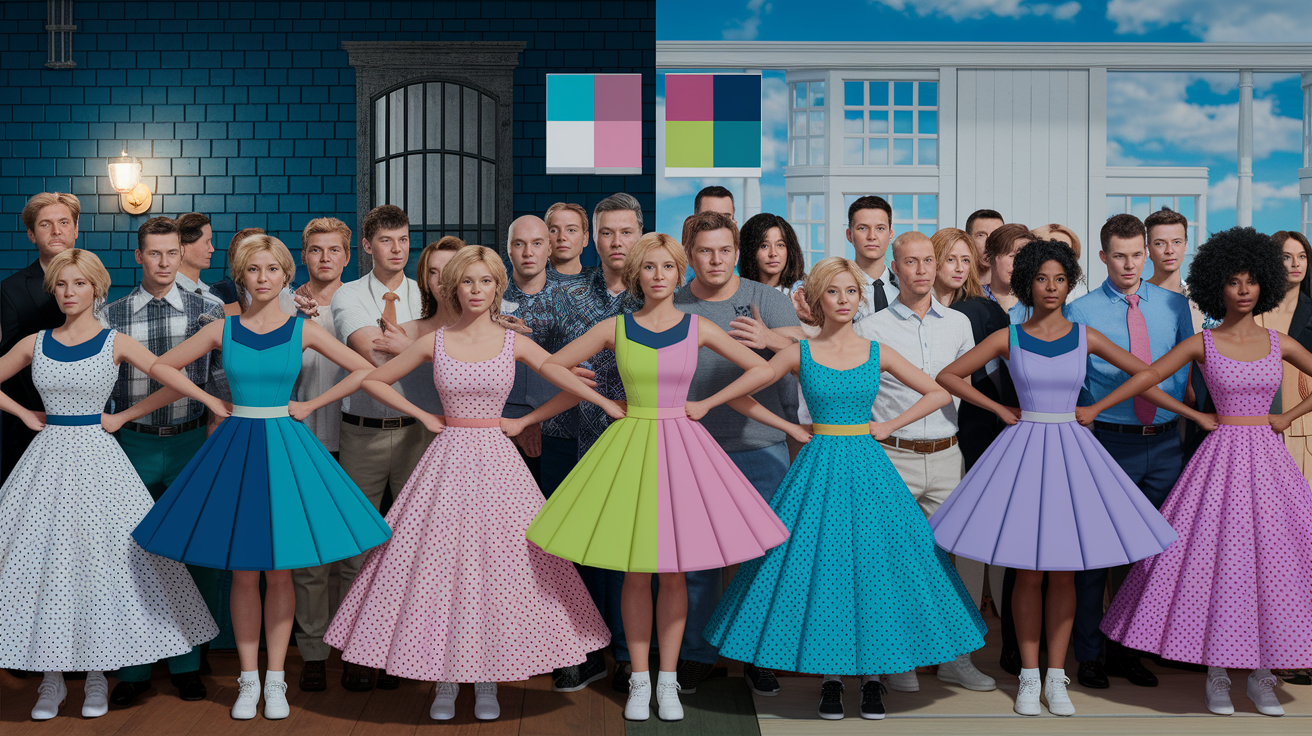
Color judgment involves three layers: the brain, the eyes, and the light around the actual dress. When combined with memory and habitual perceptions, one dress photograph can create division among people. The viral phenomenon "The Dress" illustrated this vividly; some participants perceived it as white and gold while others saw blue and black, as each viewer's system corrected the light differently under various lighting conditions.
1. Your brain
It's because our brains make a guess about the ambient light, and then 'edit' the dress to keep colours constant. It's color constancy. If your brain assumes cool daylight it can then discount blue light and nudge you toward white and gold. If it assumes warm indoor light, it may discount yellow and leave you with blue and black.
Context pushes these assumptions. A bright background or blown-out highlights can make the scene look sunlit, creating a bistable read: flip one assumption and the dress flips too. Identical pixels, two rock solid responses.
Perception relies on both memory and experience-based patterns. If you spend a lot of time looking at early-morning screens, your brain will skew one way; if you work beneath cozy warm bulbs, another. Studying why we perceive colors differently, it turns out that attention, expectations, and previous scenes shape neural color maps, and brain activity jumps across visual areas when we categorize a shade.
Your beliefs, and what studies you've read, prime what you think the "real" color has to be.
2. The light
Daylight, LED and incandescent light all shift hues in their own way. A blue dress under warm bulbs can register less blue; white fabric under blue sky can pick up cyan.
Try a dress under multiple sources—near a window at noon, neutral LEDs (about 5,000 K), then back outside in shade. Shadows and glare and walls bounce color onto cloth and twist the read. Use neutral, even light when you want the most faithful call.
3. Your eyes
Eyes are not copy-paste. Small variations in cone arrangement (the retinal mosaic) alter how we balance red, green, and blue. Some of us are tetrachromats and may split subtle shades others merge.
Age and eye health count. Yellowing lenses in older adults dampen blues. Astigmatism can blur edges, blending shades. Mild color vision deficiency closes gaps between colors. Experiment with color blindness dress tests to identify holes.
Eye colour and pigmentation can nudge sensitivity, but the impact is minor.
4. Your screen
Screens provide yet another filter. Calibration, brightness and color modes push the dress toward cool or warm. One phone will scream cobalt, another will soften it.
Verify on multiple devices and reduce auto-brightness. Remember camera's clip highlights, shift white balance and editing apps super boost contrast so pic might not even correspond to cloth in hand. For online purchases, don't make last calls without a calibrated eye or a return strategy.
5. Your memory
Memory stacks the odds. If you anticipate **white wedding dress**es, you might label near-whites as white. Trends and old pictures plant defaults that tint your current interpretation.
Compare the garment to the picture and observe where they differ. Direct observation in good, neutral light trumps memory almost always.
The dress that broke the internet
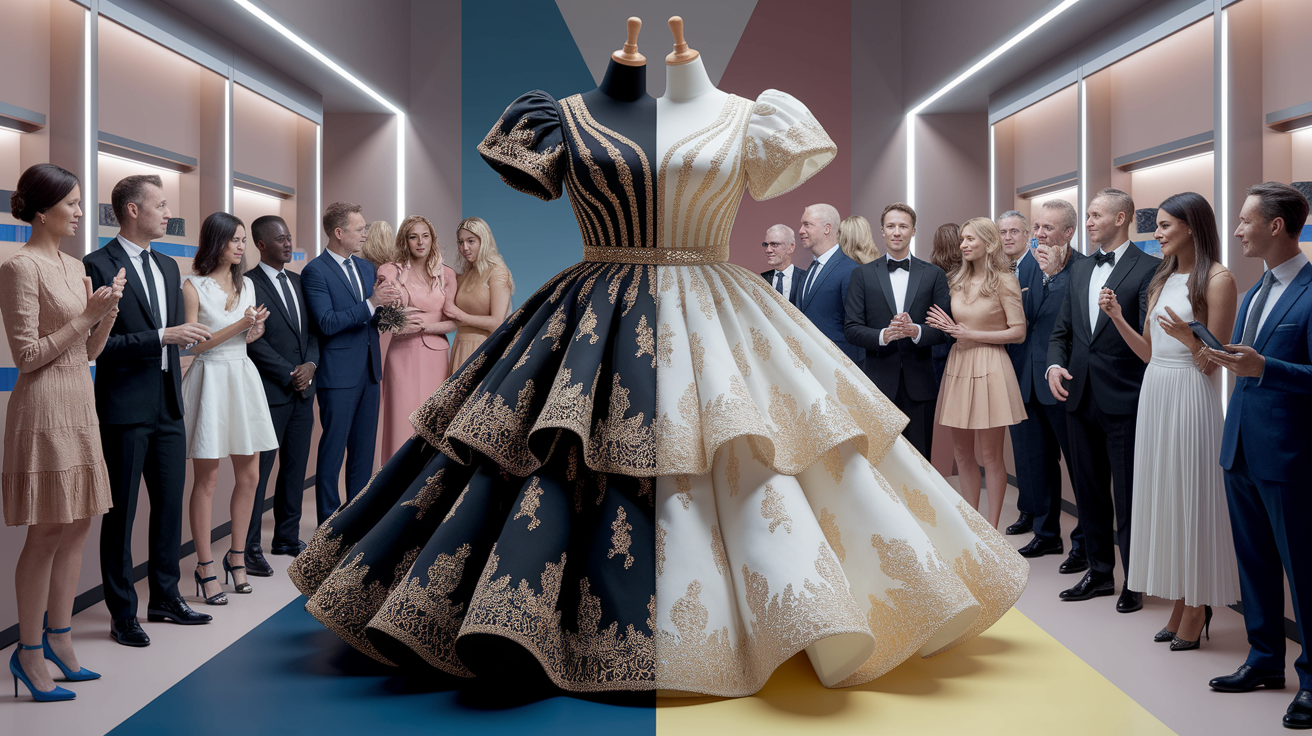
A single photograph of a lace bodycon dress, posted on 26 February 2015, split the world into two loud camps: blue-and-black or white-and-gold. Within hours, millions chimed in. Group chats stalled, newsrooms stopped, and friends fought in cafés and labs alike. The picture crossed borders quickly, in part because it hit the sweet spot of a simple question, high-stakes pride, and instant share-ability, turning into a significant cultural moment surrounding the dress image.
Celebrities poured gasoline on the fire. Musicians, actors, athletes, and talk show hosts posted their takes, catapulting the debate onto prime-time television and worldwide feeds. The more people discussed it, the more the dress photograph circulated, and the more each camp entrenched itself. The magnitude of attention transformed a smartphone snapshot into a pivotal discussion about color perception and individual judgment.
For many, the frenzy wore thin in days, yet the core question stayed sticky: how can the same pixels look so different? Retailer Roman Originals put an end to the debate about the actual dress, declaring, "THE DRESS IS BLUE AND BLACK IN REAL LIFE." Their validation, however, did not stop the argument online. It redirected the conversation from 'what is it?' to 'why do I perceive it that way?' focusing on the phenomenon of color discrimination.
That 'why' turned the photo into an instant case study for color vision, optical context, and social influence. What went down lies at the intersection of vision science and daily life. The badly lit photo, with a bright back-light and conflicting cues, illustrated the complexity of color judgments. Our brains don't read color in a vacuum; they infer the light source and then 'correct' the colors based on the ambient light conditions.
If you interpret the scene as illuminated by warm incandescent light, you may discount yellow light and perceive the dress as black and blue. If you read it as warm indoor light, you might dismiss yellow and instead see blue and black. This "dress effect" occurred first in the wild, not in a lab, which made it both rare and useful. It allowed scientists to observe collective perception as it happened, across cultures, and across age groups.
Studies ensued. One survey of 13,000 participants discovered connections between what individuals saw and their general method of interpreting visual information, such as how they make assumptions about light and context. Others experienced changes over time—one individual saw white and gold for days, then switched to blue and black on day four, emphasizing the fluidity of color perception.
The dress debate revealed that color isn't a hard fact we extract from the eye, but rather a guess our brain makes quickly. It demonstrated how social noise can influence belief even when the pixels remain constant, showcasing the intricate relationship between perception and reality in our society.
How colour affects your mood
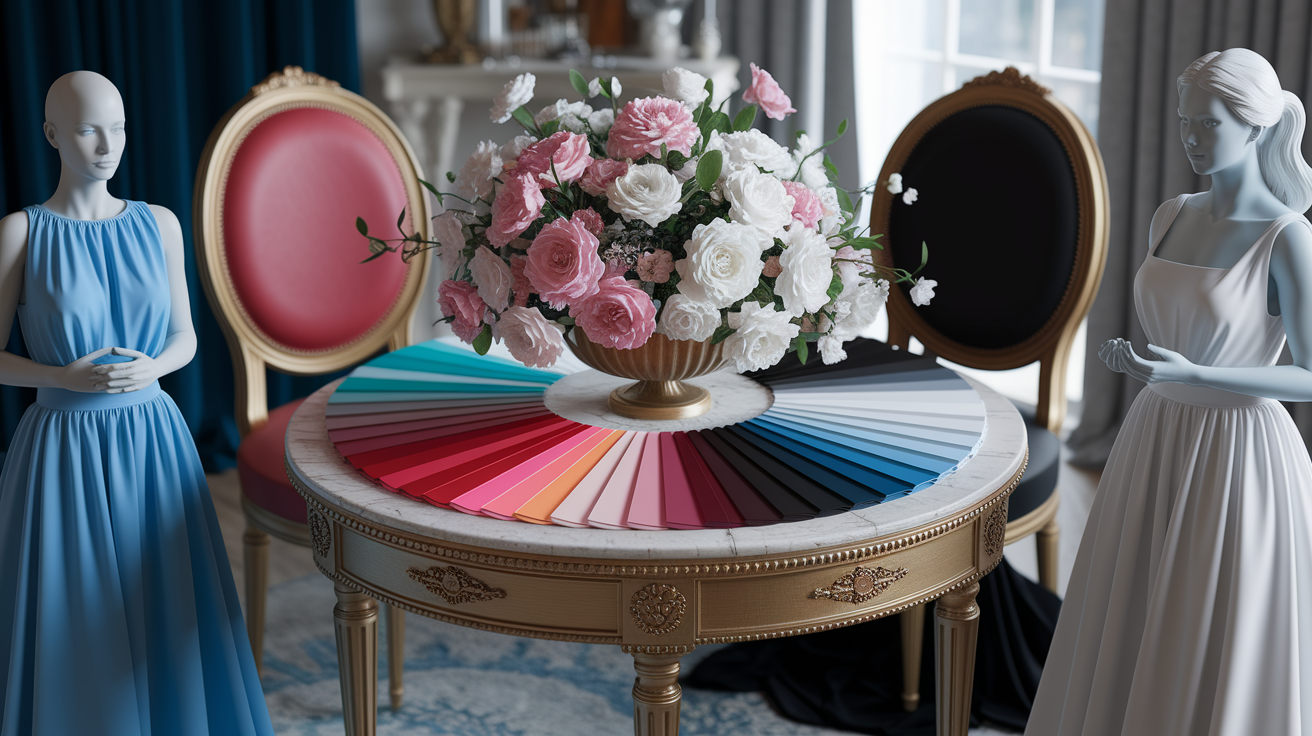
Clothes do more than cover — dress colours can nudge mood and mindset. We all wear specific shades to access self-assurance or relaxation or a bit of a thrill. These impacts aren't hard laws, but trends that emerge repeatedly in research and everyday experience.
Blue tends to read as tranquil and steady, which comes in handy when you want to be together but jitter-free. This links to light science: different wavelengths affect arousal, and blue light can raise alertness and boost attention-task performance. This could explain why blue is associated with trust and quality in branding– stores and logos in blue tend to rate highly there.
A navy dress for an important pitch whispers trustworthiness, while a gentle cornflower blouse can calm you before a hard conversation.
Red sits at the other end: high energy, fast pulse, quick draw of the eye. Studies demonstrate that red is able to capture our attention even when it is muted — we search faster for dull red targets. It influences how we perceive and ingest — people indulged less chocolate from a red plate.
On your body, a red dress can feel brash and brassy, helpful before a race or a big stage moment. If you require vitality, a red scarf or tie might suffice.
Black is sharp and pared back, interpreted as sleek and formal by many. Others think it makes them appear less accessible or more serious, which could be great at a black tie dinner and less so at a networking lunch. White skews clean and pure in a lot of areas, and can imply new beginning or deliberate purpose.
A white shift at a gallery opening seems fresh and neutral, allowing the artwork do the speaking. These signals vary with hue, lightness and chroma — the three fundamental attributes of colour. A pale blue (high lightness) soothes more than a deep cobalt.
A high-chroma red pops and thrills; a brick red steadies. Even in this one family, a warm green with more yellow can feel lively, while a cool pine green calms. Try small swaps: pick a softer lightness for ease, higher chroma for drive, cooler hue for focus, warmer hue for cheer.
Cultural and personal frames dodrum up. One color can indicate happiness somewhere and sadness somewhere else. Previous triumphs or defeats in a tone will determine how it sounds to you. Treat the colour dress test as a guide, not a verdict: notice your own lift or drag in a shade, and note the room you are walking into.
Color and mood at a glance:
- Blue: tranquility, trust, steady focus
- Red: energy, urgency, attention
- Black: sophistication, authority, possible distance
- White: purity, clarity, fresh start
Find your perfect dress colour
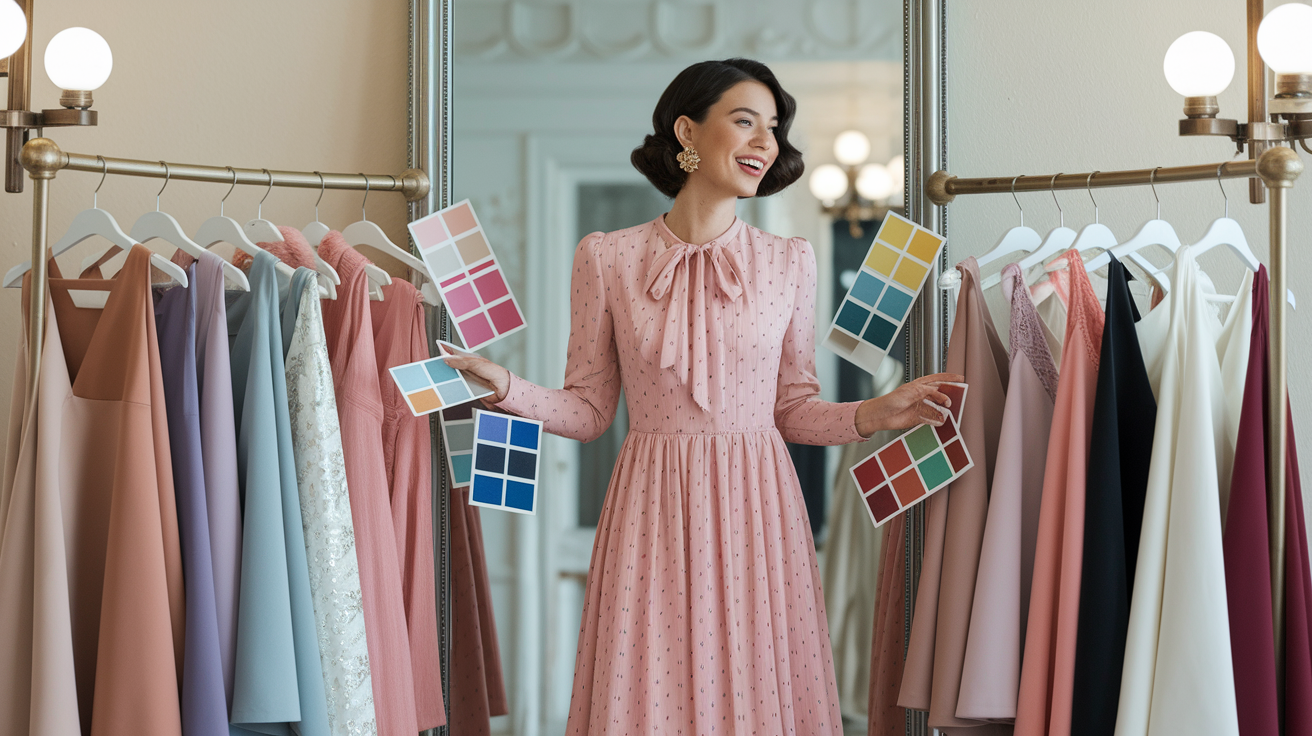
A clever dress color test begins with yourself, focusing on how the right shade can brighten your face and calm your spirit. Factors such as skin tone, hair color, and eye color play a role in color perception. Stay flexible and continue experimenting with different clothing combinations, as minor changes can tip your optimum palette.
Skin undertone
Start by spotting your undertone: cool, warm, or neutral. Look at your veins in daylight; bluish tints mean cool, greenish warm, and a mix neutral. Hold a white wedding dress to your face; if your skin looks rosy or pink, cool; if it looks golden or peachy, warm. Neutral feels balanced. This step is important because undertone influences how colors bounce off your skin and can be the difference between glowing and washed out.
Jewel tones and cool blues marvellously flatter cool undertones. Consider sapphire, emerald, true red, icy pink, and navy. Warm undertones adore earthy tones and golds—olive, terracotta, mustard, coral, and warm reds. If your hair color changes—say, dark brown to honey blonde—re-double check; your dress photo colors might fade or glow more warm.
Here's a quick test: use your jewellery! Silver tends to light up cool undertones, and gold glows on warm. If both do, then you're probably neutral and can play in a broader field.
- Cool: sapphire, emerald, ruby red, fuchsia, cobalt, icy gray
- Warm: coral, tomato red, mustard, olive, teal-green, camel
- Neutral: soft rose, dusty blue, charcoal, taupe, true navy, plum
The occasion
For work or formal daytime, muted colours—charcoal, navy, forest, soft burgundy—show calm and care. Vibrant hues dazzle at parties and festivals, where vitality photographs beautifully and radiates in real life. Black continues to be a go-to for evening and formal occasions—solid and seasonless.
White is for weddings in most cultures—if you're a guest, opt for cream, pale blue or blush. Colour implications can move by location. Look it up before international or cross‑cultural events to sidestep mixed messages—red, for example, can signify luck, power, or mourning.
- Work (all seasons): navy, charcoal, forest, muted plum
- Cocktail/evening: black, deep red, ink blue, metallics in small doses
- Day parties: coral, periwinkle, mint, sunflower
- Weddings (guest): pastels, jewel tones, soft prints; avoid white
- Summer: light neutrals, sky blue, fresh green
- Winter: rich tones—oxblood, emerald, midnight, warm metallic accents
Personal style
Color yourself confident. Beloved hues, dramatic patterns, or soft tones – all are fine if they harmonize with your features and comfort you. Balance trend colors with timeless staples—so a neon moment sits next to navy, black, taupe and cream.
Color analysis can help you map a profile — your best lights, mids and deeps — so you shop with purpose and pass by racks that dim your shine. Confidence grows when your dress colour suits your tone, hair and style.
- Pair complements: blue with orange-peach, green with soft pink, purple with yellow cream
- Anchor brights with neutrals: coral + taupe, cobalt + gray, lime + navy
- Try it out with scarves, belts and shoes before you purchase a dress
- Shift with hair changes: warm up after highlights, cool down after going dark
The colour dress test quiz
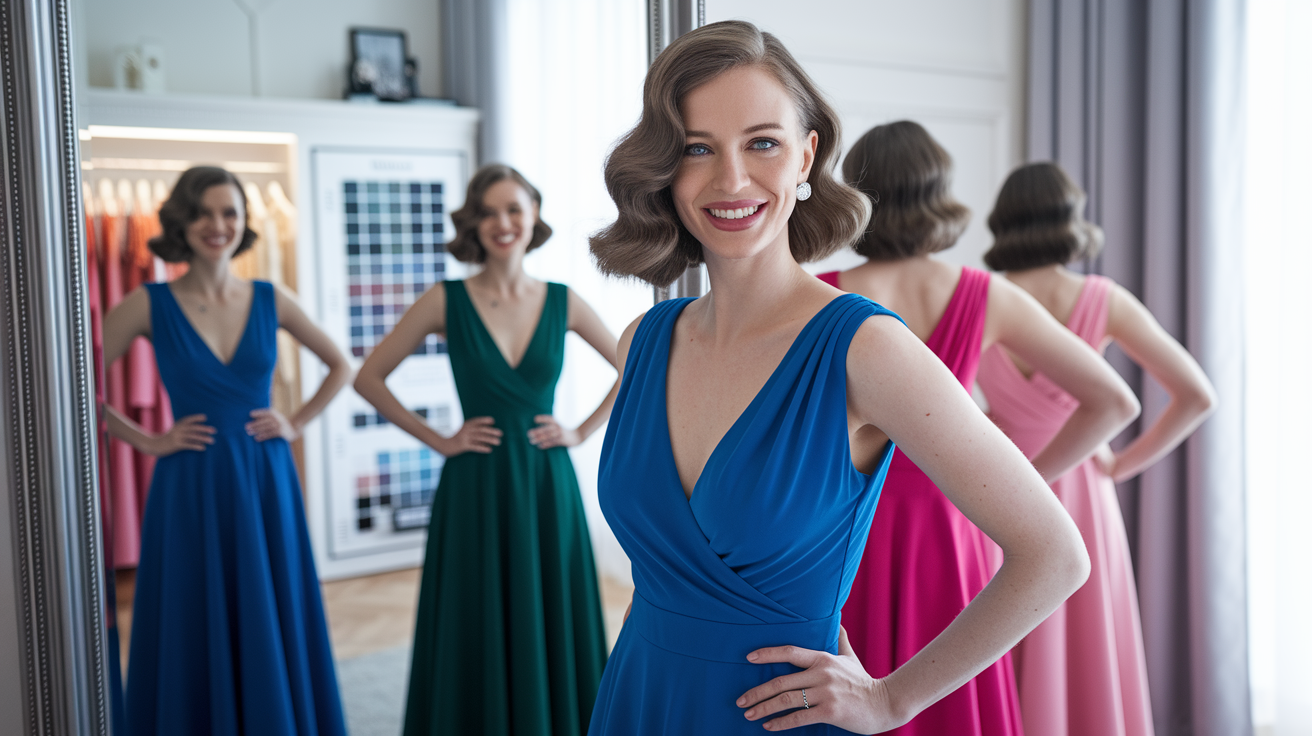
A simple, fast quiz can guide you toward typical colors for your dress that match your look and vibe. It connects what you like with what flatters you, transforming that into straightforward selections you can immediately wear.
Propose taking a color dress test quiz to discover which dress colors best suit your personality and appearance.
The quiz starts with a simple goal: find shades that match your traits and your skin, hair, and eyes. It questions about mood and style, because a brazen individual might desire a fiery red while a relaxed dresser gravitates toward gentle sage.
You receive a bunch of color families, not one strict rule, so you can experiment with options among seasons, occasions & light. This is important because color is not static. Think of the viral dress that split the world: some saw white and gold, others blue and black. It was the same picture, but people fought for days!
That story is a good reminder that context and the way we perceive color alter decisions in real life as well.
Include questions on skin tone, hair color, eye color, and style preferences for personalized results.
Key inputs influence your map. Skin tone (light, medium or deep) and undertone (cool, warm, neutral) steer your base hues. Hair color, black to silver, contributes contrast prompts.
Eye color — brown, hazel, green, blue — assists choose accents that make your gaze pop. Style prompts keep it real: do you like clean lines, prints, pastels, or jewel tones? Plus use cases—work, nights out, weddings—and budget.
Example: medium skin with warm undertone, dark brown hair, green eyes, minimal style, office wear. The quiz could categorize olive, teal, rust, and charcoal as core picks, and recommend rose gold over silver.
Offer instant feedback with recommended dress colours and outfit ideas based on quiz answers.
Results arrive as a short list: primary colors, safe neutrals, and two wild cards. Each accompanied with outfit inspiration. For a cool undertone with light hair, go for royal blue, deep plum and crisp white.
Accessorize with a soft gray blazer and silver watch. Warm undertone, dark curls – coral, camel, and forest green. Camel midi + green wrap + tan flats.
The dress debate teaches a tech tip: light changes color. The viral picture was overexposed with bad white balance, which washed colors. So the quiz nudges you to test picks in daylight (around 10:00–14:00), indoor warm light, and evening light.
Suggest sharing quiz results with friends for fun and fashion inspiration.
Send your palette to a friend group and crowdsource new looks. As of 1 March, more than two thirds of surveyed users reported the viral dress as being white and gold, and some were witnessing it change colors.
Others insisted that it was blue and black. Science later confirmed it was a royal blue Lace Bodycon Dress with black lace, and a neuroscientist and psychologist said it was the first color stimulus pushed into science by social media.
Over ten million tweets in a week demonstrated just how far that debate spread, grounded in color constancy—our brains extrapolate the "actual" shade under unusual lighting.
Your group chat can use that insight: swap photos of outfits in different light and see what holds up across eyes and screens.
Beyond the screen and store
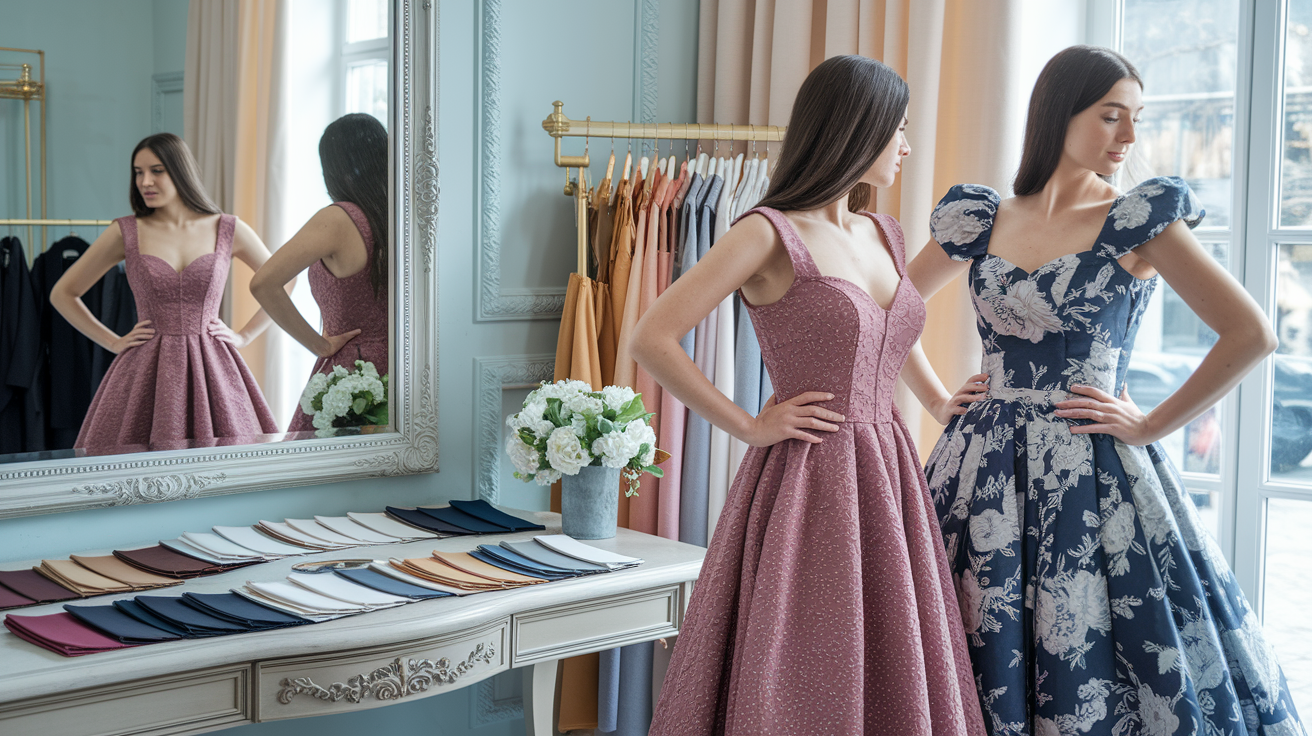
Color dress tests happen in the real world, not just on pixels. Color is mental, not merely ocular perception, and screens provide their own special distortion. What you believe you perceive online is mediated by a display's color calibration, image compression, and your brain's pattern matching. The viral 'white wedding dress' or 'black dress' phenomenon demonstrated that beautifully. Some observed one combination, while others saw the reverse, and both were confident in their judgments.
The reason ties to color constancy: your visual system tries to discount the chromatic bias of the daylight axis and set a stable read of color. Brains accomplish this by creating a new baseline from the ambient room light and surrounding hues. Morning or evening light casts warm, yellow hues, while mid-afternoon daylight leans cool and blue. Personal history and learned associations weigh in as well. That's why two people, with the same biology, still read color in their own way, leading to different color judgments.
Try on dresses in person under different lighting before you make a purchase. Step back from warm store LEDs to store daylight bulbs and shaded outdoor light. Walk by a window at noon, then around dusk. Take a neutral white card to reset your eye. Stand against a gray wall – not a vibrant display rack – to reduce color bleed and ensure you see the actual color of the dress.
Snap a fast picture, but eyeball it. If you're going to be wearing the dress at nighttime occasions, test it under soft warm light. If it's for day use, go outside and check in open shade. Try this with two sizes and two near shades. The 'correct colors' tend to only reveal themselves when worn in various lighting conditions.
Fabric type, shine, and build shift how a color comes across. A matte cotton can mute a bold red, while satin makes the same red look louder and cooler. Sequins, beads or metallic thread throw highlights that shift the read by angle. Balance the outfit as a set: dress, shoes, bag, and skin tone.
If the dress is high-chroma, anchor it with matte, low-sheen pieces. If the dress is pale, bring it to life with texture, like a knit wrap. Consider the location where you wear it and how light will shift over the course of the day, as these factors can influence your color perception.
| Fabric | Surface | Typical color perception |
|---|---|---|
| Cotton poplin | Matte | Softer, slightly warm; stable in daylight |
| Linen | Matte, slub | Desaturated; can look dusty in shade |
| Wool crepe | Matte, dense | Deepened tones; reads rich, low glare |
| Silk satin | High sheen | Brighter, cooler shift at angles |
| Chiffon | Sheer, layered | Lightened; background can tint hue |
| Velvet | Pile, light‑trap | Darker, saturated; shifts with pile direction |
| Sequins/lamé | Mirror‑like | Strong glare; hue skew under spotlights |
Human intuition triumphs over computer approximation every time for a closet that suits and surprises. The mind establishes a moving baseline based on illumination and context, and previous encounters might steer you towards specific color combinations. Use that fact, not fight it: test, compare, and build your picks around how colors look on you, in your places, across your day.
Conclusion
In short, color influences not only our mood but how we appear and how we perceive the world. The viral dress, it turns out, showed that our eyes and light pulled a prank. Mood changes with color. Style shifts. A deep blue can soothe. A vivid red can ignite warmth. Soft green will soothe the nerves. A warm gold can lift the face on a gray day.
If you're going to pick a dress, test in real light. Stand close to a window. Hold swatches next to your skin. Snap pics on your phone. Get a second opinion. Give one daring choice for kicks. Save one sure thing for work.
To find your match, take the quiz, save your top three shades and try them on this week. Your mirror will be honest.
Frequently Asked Questions
Why do people see the same dress in different colors?
Our brains process light in different ways, influenced by ambient light and individual perception. Factors like lighting conditions and screen calibration affect how people see colors, leading to varied color judgments and interpretations of the actual dress.
What was "the dress that broke the internet" about?
In 2015, a photograph of a dress went viral, sparking debates about color judgments. Some participants perceived it as white and gold, while others saw the actual dress as blue and black, highlighting how individual perception varies under different lighting conditions.
Can color actually affect my mood?
Yes. There's a whole body of research indicating that color judgments can impact emotion and behavior. For instance, blue might feel calming while red can be energizing, influenced by cultural and experiential effects. Try color combinations in your real life for best results.
How do I find my best dress color?
Start with your undertone: cool, warm, or neutral. Cool undertones suit jewel tones, while warm undertones suit earth tones. For the best color perception, try to test colors in natural light and compare against your own skin, hair, and eye color for harmony.
What is the "color dress test" quiz?
It's a fast quiz to pair tones with your undertone and style. You respond to queries regarding skin, eye, and hair color under different lighting conditions. It proposes a palette you can test out in real life, serving as a guide for color combinations, not a law.
Why do colors look different on my screen and in-store?
Screens have varying brightness and color profiles, which can affect color perception. Store lighting can also alter perceptions of the actual dress. Always test in natural light when possible, and if purchasing online, review multiple dress photographs and check return policies.
Are there universal colors that flatter most people?
Yes. Some mid-tone shades like teal, soft berry, and true navy tend to work across undertones. Still, try them on in your lighting conditions, as the actual dress fit and fabric play into what is flattering for a color.